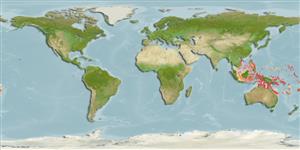>
Gobiiformes (Gobies) >
Gobiidae (Gobies) > Gobiinae
Etymology: Signigobius: Name from Latin, signus for mark and gobius for a genus of fish, referring to its distinctive coloration.; biocellatus: Name from Latin bi meaning two and ocellatus for small eye spots, referring to the 2 prominent ocellated spots on the dorsal fins..
More on authors: Hoese & Allen.
Environment: milieu / climate zone / depth range / distribution range
Écologie
marin récifal; profondeur 1 - 30 m (Ref. 1602), usually 2 - 30 m (Ref. 27115). Tropical; 22°C - 27°C (Ref. 27115); 19°N - 24°S
Western Pacific: Philippines to the Solomon Islands and Vanuatu, south to the southern Great Barrier Reef; Palau in Micronesia.
Taille / Poids / Âge
Maturity: Lm ? range ? - ? cm
Max length : 10.0 cm SL mâle / non sexé; (Ref. 48637)
Description synthétique
Clés d'identification | Morphologie | Morphométrie
Épines dorsales (Total) : 7; Rayons mous dorsaux (Total) : 10 - 11; Épines anales: 1; Rayons mous anaux: 10 - 11. Conspicuous ocellated dorsal fins (Ref. 90102); characterized by pale bluish grey to yellowish tan; narrow brown bar below eye; upper half of body with irregular brown spot and saddles; three irregular brown bars on lower half of body; narrow brown bar across base of caudal fin; pelvic and anal fins black with blue spots; rounded caudal fin; longitudinal scale series 48-55; mainly ctenoid body scales posteriorly, becoming cycloid anteriorly just behind pectoral base and below first dorsal fin; cycloid on ventral surface of abdomen; head and midline of nape without scales; depth of body 4.3-5.6 in SL (Ref. 90102).
Adults occur in sandy to silty bottoms of lagoons and coastal bays near coral, rubble or leaf litter shelter. Solitary or in pairs that share sandy burrows (Ref. 90102). Feed on small interstitial invertebrates by sifting mouthfuls of sand. Monogamous (Ref. 52884, 48637).
Life cycle and mating behavior
Maturities | Reproduction | Spawnings | Egg(s) | Fecundities | Larves
Monogamous mating is observed as both obligate and social (Ref. 52884).
Allen, G.R. and R. Swainston, 1992. Reef fishes of New Guinea: a field guide for divers, anglers and naturalists. Publication No. 8. Christensen Research Institute, Madang, Papua New Guinea. 132 p. (Ref. 6023)
Statut dans la liste rouge de l'IUCN (Ref. 130435)
Menace pour l'homme
Harmless
Utilisations par l'homme
Pêcheries: sans intérêt; Aquarium: Commercial
Outils
Articles particuliers
Télécharger en XML
Sources Internet
Estimates based on models
Preferred temperature (Ref.
123201): 25.8 - 28.9, mean 27.7 °C (based on 350 cells).
Phylogenetic diversity index (Ref.
82804): PD
50 = 1.0000 [Uniqueness, from 0.5 = low to 2.0 = high].
Bayesian length-weight: a=0.01023 (0.00477 - 0.02194), b=3.02 (2.84 - 3.20), in cm total length, based on LWR estimates for this (Sub)family-body shape (Ref.
93245).
Niveau trophique (Ref.
69278): 3.5 ±0.37 se; based on food items.
Résilience (Ref.
120179): Haut, temps minimum de doublement de population inférieur à 15 mois (Preliminary K or Fecundity.).
Fishing Vulnerability (Ref.
59153): Low vulnerability (10 of 100).
Nutrients (Ref.
124155): Calcium = 108 [58, 218] mg/100g; Iron = 0.771 [0.403, 1.406] mg/100g; Protein = 18.5 [16.7, 20.2] %; Omega3 = 0.157 [0.071, 0.270] g/100g; Selenium = 21.2 [11.4, 41.4] μg/100g; VitaminA = 149 [43, 452] μg/100g; Zinc = 1.79 [1.21, 2.64] mg/100g (wet weight);
